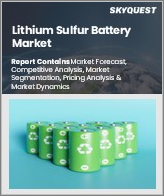
리튬 황 배터리 세계 시장 규모는 2023년 17억 달러, 2024년 21억 6,000만 달러에서 2032년에는 149억 2,000만 달러로 성장하고, 예측 기간(2025-2032년) CAGR은 27.3%를 보일 것으로 예측됩니다.
리튬 황 배터리 시장은 기존 리튬이온전지에 비해 에너지 밀도가 높고, 무게가 가볍고, 비용이 저렴하다는 장점으로 인해 크게 성장하고 있습니다. 이러한 장점은 에너지 효율과 경량화의 필요성으로 인해 전기자동차, 항공우주, 재생 가능 에너지 저장 등의 분야에서 점점 더 매력적으로 변하고 있습니다. 리튬유황 배터리는 생태학적 발자국이 작고 코발트 및 희토류 재료에 대한 의존도가 낮기 때문에 지속가능성과 친환경 솔루션에 대한 관심이 높아지면서 시장 잠재력이 더욱 커지고 있습니다. 또한, 윤리적 조달 및 공급망 문제에 대한 인식이 높아짐에 따라 제조업체들은 지속가능성을 높이기 위해 이러한 배터리를 채택하고 있습니다. 지속적인 기술 발전, 공동 연구 노력 및 정부 지원 이니셔티브는 기존 문제를 해결하고 리튬유황 배터리의 광범위한 적용을 촉진할 것으로 예측됩니다.
Global Lithium Sulfur Battery Market size was valued at USD 1.7 billion in 2023 and is poised to grow from USD 2.16 billion in 2024 to USD 14.92 billion by 2032, growing at a CAGR of 27.3% during the forecast period (2025-2032).
The lithium-sulfur battery market is witnessing significant expansion due to its superior energy density, reduced weight, and lower costs compared to traditional lithium-ion batteries. These advantages are increasingly appealing to sectors such as electric vehicles, aerospace, and renewable energy storage, driven by the need for energy efficiency and weight reduction. The growing emphasis on sustainability and environmentally friendly solutions further boosts market potential, as lithium-sulfur batteries present a smaller ecological footprint and reduce reliance on cobalt and rare-earth materials. Additionally, heightened awareness regarding ethical sourcing and supply chain challenges encourages manufacturers to adopt these batteries to enhance sustainability. Ongoing technological advancements, collaborative research efforts, and supportive government initiatives are anticipated to tackle existing challenges and facilitate broader application of lithium-sulfur batteries.
Top-down and bottom-up approaches were used to estimate and validate the size of the Global Lithium Sulfur Battery market and to estimate the size of various other dependent submarkets. The research methodology used to estimate the market size includes the following details: The key players in the market were identified through secondary research, and their market shares in the respective regions were determined through primary and secondary research. This entire procedure includes the study of the annual and financial reports of the top market players and extensive interviews for key insights from industry leaders such as CEOs, VPs, directors, and marketing executives. All percentage shares split, and breakdowns were determined using secondary sources and verified through Primary sources. All possible parameters that affect the markets covered in this research study have been accounted for, viewed in extensive detail, verified through primary research, and analyzed to get the final quantitative and qualitative data.
Global Lithium Sulfur Battery Market Segments Analysis
Global Lithium Sulfur Battery Market is segmented by Component, Type, Capacity, Application and region. Based on Component, the market is segmented into Cathode, Anode, Electrolyte and Other Components. Based on Type, the market is segmented into Liquid, Semi-solid and Solid-state. Based on Capacity, the market is segmented into Below 500 mAh, 501 mAh to 1,000 mAh and Above 1,000 mAh. Based on Application, the market is segmented into Aerospace, Automotive & Transportation, Consumer Electronics, Power and Medical. Based on region, the market is segmented into North America, Europe, Asia Pacific, Latin America and Middle East & Africa.
Driver of the Global Lithium Sulfur Battery Market
The global shift towards electric mobility and renewable energy storage has greatly increased the need for high-energy-density batteries. Lithium-Sulfur (Li-S) batteries are attracting significant attention due to their remarkable theoretical energy density, which is about five times greater than that of conventional lithium-ion batteries. This characteristic makes them ideal for various applications, including electric vehicles (EVs), unmanned aerial vehicles (UAVs), and portable electronics that require long-lasting power sources. Furthermore, the rising use of Li-S batteries in military and aerospace sectors, where lightweight and efficient energy storage is essential, enhances their market demand. As manufacturers of electric vehicles pursue effective battery solutions with improved range, Li-S batteries are becoming a viable alternative.
Restraints in the Global Lithium Sulfur Battery Market
The Global Lithium Sulfur Battery market faces significant challenges primarily due to the limited cycle life of Li-S batteries, which is a critical drawback despite their high energy density. As these batteries undergo charging and discharging cycles, the formation of lithium polysulfides becomes a persistent issue, leading to the loss of active materials. This results in a gradual decline in capacity and operational efficiency. The polysulfides tend to dissolve in the electrolyte and can migrate to the anode, causing instabilities in performance. Although research efforts are being directed toward solutions like solid-state electrolytes and innovative electrode designs, effectively addressing this limitation remains a formidable obstacle that hinders widespread commercial usage.
Market Trends of the Global Lithium Sulfur Battery Market
The global lithium-sulfur battery market is experiencing a transformative trend driven by advancements in artificial intelligence. AI is optimizing battery design and manufacturing processes, significantly enhancing performance, lifespan, and quality control. By predicting potential issues and adjusting charging cycles, AI extends battery longevity while maintaining consistent output. This is particularly impactful for lithium-sulfur batteries, renowned for their high energy density and lightweight characteristics, making them increasingly suitable for applications in electric vehicles, portable electronics, and drones. As manufacturers adopt AI technologies, the lithium-sulfur battery market is poised for substantial growth, underscoring the shift towards more efficient sustainable energy solutions.